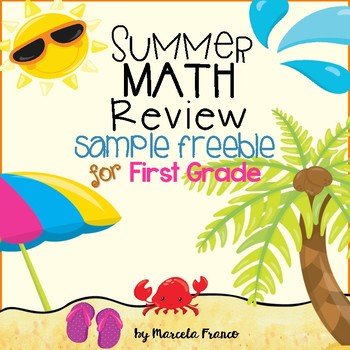Marcela Franco- One Heart One Classroom
966 Followers
Grade Levels
1st - 2nd, Homeschool
Subjects
Resource Type
Standards
CCSS1.NBT.A.1
CCSS1.NBT.C.4
CCSS1.NBT.C.5
CCSS1.NBT.C.6
CCSS1.OA.C.6
Formats Included
- PDF
Pages
6 pages
Marcela Franco- One Heart One Classroom
966 Followers
Description
Happy Summer! Here are a few fun themed pages for your almost second graders to review some important math skills.
Included you will find:
-Double Digit Addition Worksheet
-Missing Addend worksheet
-Subtraction Worksheet
-Writing numbers to 120 chart
-Counting Coins Worksheet (US Currency)
-Board Game (adding 10 and subtracting 10 from a number)
I hope you enjoy it!
*****************************************************************************
This is a sample of my Summer Math Review for First Grade resource that you can find here:
Summer Math Review for First Grade
Thank you so much for stopping by!
Blessings,
Marcela Franco
Included you will find:
-Double Digit Addition Worksheet
-Missing Addend worksheet
-Subtraction Worksheet
-Writing numbers to 120 chart
-Counting Coins Worksheet (US Currency)
-Board Game (adding 10 and subtracting 10 from a number)
I hope you enjoy it!
*****************************************************************************
This is a sample of my Summer Math Review for First Grade resource that you can find here:
Summer Math Review for First Grade
Thank you so much for stopping by!
Blessings,
Marcela Franco
Total Pages
6 pages
Answer Key
N/A
Teaching Duration
N/A
Report this resource to TPT
Reported resources will be reviewed by our team. Report this resource to let us know if this resource violates TPT’s content guidelines.
Standards
to see state-specific standards (only available in the US).
CCSS1.NBT.A.1
Count to 120, starting at any number less than 120. In this range, read and write numerals and represent a number of objects with a written numeral.
CCSS1.NBT.C.4
Add within 100, including adding a two-digit number and a one-digit number, and adding a two-digit number and a multiple of 10, using concrete models or drawings and strategies based on place value, properties of operations, and/or the relationship between addition and subtraction; relate the strategy to a written method and explain the reasoning used. Understand that in adding two-digit numbers, one adds tens and tens, ones and ones; and sometimes it is necessary to compose a ten.
CCSS1.NBT.C.5
Given a two-digit number, mentally find 10 more or 10 less than the number, without having to count; explain the reasoning used.
CCSS1.NBT.C.6
Subtract multiples of 10 in the range 10-90 from multiples of 10 in the range 10-90 (positive or zero differences), using concrete models or drawings and strategies based on place value, properties of operations, and/or the relationship between addition and subtraction; relate the strategy to a written method and explain the reasoning used.
CCSS1.OA.C.6
Add and subtract within 20, demonstrating fluency for addition and subtraction within 10. Use strategies such as counting on; making ten (e.g., 8 + 6 = 8 + 2 + 4 = 10 + 4 = 14); decomposing a number leading to a ten (e.g., 13 - 4 = 13 - 3 - 1 = 10 - 1 = 9); using the relationship between addition and subtraction (e.g., knowing that 8 + 4 = 12, one knows 12 - 8 = 4); and creating equivalent but easier or known sums (e.g., adding 6 + 7 by creating the known equivalent 6 + 6 + 1 = 12 + 1 = 13).





